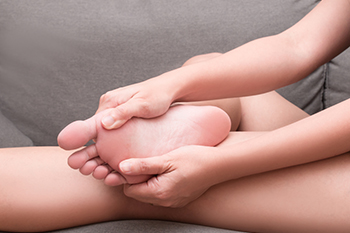Connect With Us
Blog
Items filtered by date: February 2023
Common Foot Problems During Pregnancy

Most women who are pregnant experience some type of foot problem. The most common are swelling, collapsed arches, plantar fasciitis, and dry or cracked heels. Swelling in the feet is generally the result of constricted blood flow to the lower extremities, caused by pressure on the veins in the pelvic region. This results in a condition called edema, where blood and fluids collect in the feet and ankles. A podiatrist can offer simple solutions to this problem. Added weight during pregnancy often results in a collapse of the arches, which may affect stability. Wearing supportive shoes with ample arch support is often recommended by podiatrists. Pain in the heel is generally caused by tears to the band of tissue under the feet, called plantar fascia. Proper footwear and performing a series of exercises can help relieve the pain. Finally, cracked heels may result from a change in hormonal balance during pregnancy that causes a loss in elasticity and moisture in the feet. This can be solved by moisturizing the feet daily. For further help with any type of foot pain during pregnancy, it is suggested that you consult a podiatrist.
Pregnant women with swollen feet can be treated with a variety of different methods that are readily available. For more information about other cures for swollen feet during pregnancy, consult with Dr. Richard Silverstein from Union Foot Care. Our doctor will attend to all of your foot and ankle needs.
What Foot Problems Can Arise During Pregnancy?
One problem that can occur is overpronation, which occurs when the arch of the foot flattens and tends to roll inward. This can cause pain and discomfort in your heels while you’re walking or even just standing up, trying to support your baby.
Another problem is edema, or swelling in the extremities. This often affects the feet during pregnancy but tends to occur in the later stages.
How Can I Keep My Feet Healthy During Pregnancy?
- Wearing orthotics can provide extra support for the feet and help distribute weight evenly
- Minimize the amount of time spent walking barefoot
- Wear shoes with good arch support
- Wear shoes that allow for good circulation to the feet
- Elevate feet if you experience swelling
- Massage your feet
- Get regular, light exercise, such as walking, to promote blood circulation to the feet
If you have any questions please feel free to contact our office located in Havre de Grace, MD . We offer the newest diagnostic and treatment technologies for all your foot and ankle needs.
Inflammation Under the Big Toe May Be Sesamoiditis

There are bones that are found inside the muscle under the big toe called the sesamoid bones. Their function is to act as a shock absorber for the ball of the foot, and sesamoiditis may happen if they become inflamed. This can result from excess force while running and jumping and can cause pain and discomfort. Additional reasons why this condition can occur from stumbling or slipping or if the toe suddenly bends upward. Further, having an abnormal foot structure or frequently wearing high heels may cause sesamoiditis to develop. Common symptoms associated with this condition include pain while pushing off when walking or running, and swelling surrounding the big toe. Relief may be felt when the foot is elevated, and orthotics are worn that can help to support the foot as it heals. If you have pain under the big toe, it is suggested that you consult with a podiatrist as quickly as possible who can correctly diagnose and treat sesamoiditis.
Sesamoiditis is an unpleasant foot condition characterized by pain in the balls of the feet. If you think you’re struggling with sesamoiditis, contact Dr. Richard Silverstein of Union Foot Care. Our doctor will treat your condition thoroughly and effectively.
Sesamoiditis
Sesamoiditis is a condition of the foot that affects the ball of the foot. It is more common in younger people than it is in older people. It can also occur with people who have begun a new exercise program, since their bodies are adjusting to the new physical regimen. Pain may also be caused by the inflammation of tendons surrounding the bones. It is important to seek treatment in its early stages because if you ignore the pain, this condition can lead to more serious problems such as severe irritation and bone fractures.
Causes of Sesamoiditis
- Sudden increase in activity
- Increase in physically strenuous movement without a proper warm up or build up
- Foot structure: those who have smaller, bonier feet or those with a high arch may be more susceptible
Treatment for sesamoiditis is non-invasive and simple. Doctors may recommend a strict rest period where the patient forgoes most physical activity. This will help give the patient time to heal their feet through limited activity. For serious cases, it is best to speak with your doctor to determine a treatment option that will help your specific needs.
If you have any questions please feel free to contact our office located in Havre de Grace, MD . We offer the newest diagnostic and treatment technologies for all your foot and ankle needs.
Reasons You May Need to See a Foot Doctor

Taking care of your feet is a lifelong responsibility, as they get you where you need to go. Sometimes, a foot problem or other condition that affects the feet calls for more attention than a normal foot care regime can provide. In such cases, it is a good idea to consult a podiatrist, who is a doctor trained in the care and problems of the feet, toes, and ankles. A podiatrist can diagnose and treat a variety of foot-related problems, especially if you are experiencing pain. Problems commonly treated by podiatrists include ingrown toenails, sprained ankles, corns or calluses, and bunions. Foot or toe infections, such as athlete’s foot or fungal toenail infections, are also treated by podiatrists. Blisters and sores that do not heal properly, numbness in feet and toes, and unexplained swelling in the feet and ankles can be treated by podiatrists. Cracked heels or heel fissures, bruising, or discoloration of the toes or feet are other reasons to visit a podiatrist. People with underlying conditions, including diabetes and peripheral artery disease, may wish to schedule regular appointments with a podiatrist, as these diseases often affect the health of your feet. For more information, consult a podiatrist today.
If you are dealing with pain in your feet and ankles, you may want to seek help from a podiatrist. Feel free to contact Dr. Richard Silverstein from Union Foot Care. Our doctor can provide the care you need to keep you pain-free and on your feet.
What Is a Podiatrist?
A podiatrist is a doctor of podiatric medicine who diagnoses and treats conditions of the foot, ankle, and related structures of the leg. Your podiatrist may specialize in a certain field such as sports medicine, wound care, pediatrics, and diabetic care. Podiatrists have the ability to become board certified through training, clinical experience, and then taking an exam.
What Do Podiatrists Do?
On a daily basis, a podiatrist may perform the following activities:
- Diagnose foot ailments such as ulcers, tumors, fractures, etc.
- Use innovative methods to treat conditions
- Use corrective orthotics, casts, and strappings to correct deformities
- Correct walking patterns and balance
- Provide individual consultations to patients
It is very important that you take care of your feet. It’s easy to take having healthy feet for granted, however foot problems tend to be among the most common health conditions. Podiatrists can help diagnose and treat a variety of feet related conditions, so it is crucial that you visit one if you need assistance.
If you have any questions please feel free to contact our office located in Havre de Grace, MD . We offer the newest diagnostic and treatment technologies for all your foot and ankle needs.
Heel Pain Can Be Treated!
Various Reasons for Ankle Pain

There are many reasons why people can experience ankle pain. These include ailments that range from chronic conditions consisting of arthritis to minor injuries such as an ankle sprain. Ankle pain can happen from damage that has been done to the muscles and soft tissues that support the ankle, and it can interfere with walking. Swelling can often accompany ankle pain, and it is suggested to seek medical attention. An Achilles tendon injury can radiate to the ankle, and this can happen suddenly or gradually. It causes difficulty to stand on tiptoes, and there may be a limited range of motion. Severe pain is generally present if the ankle has fractured, and treatment can require wearing a supportive boot or cast. People who have frequent gout attacks may notice that they have ankle pain. This is considered to be a form of arthritis, and the ankle joints may become inflamed. If you have ankle pain for any reason, please contact a podiatrist as quickly as possible. This doctor can determine what the cause is, and choose the best treatment for it.
Ankle pain can have many different causes and the pain may potentially be serious. If you have ankle pain, consult with Dr. Richard Silverstein from Union Foot Care. Our doctor will assess your condition and provide you with quality foot and ankle treatment.
Ankle pain is any condition that causes pain in the ankle. Due to the fact that the ankle consists of tendons, muscles, bones, and ligaments, ankle pain can come from a number of different conditions.
Causes
The most common causes of ankle pain include:
- Types of arthritis (rheumatoid, osteoarthritis, and gout)
- Ankle sprains
- Broken ankles
- Achilles tendinitis
- Achilles tendon rupture
- Stress fractures
- Tarsal tunnel syndrome
- Plantar fasciitis
Symptoms
Symptoms of ankle injury vary based upon the condition. Pain may include general pain and discomfort, swelling, aching, redness, bruising, burning or stabbing sensations, and/or loss of sensation.
Diagnosis
Due to the wide variety of potential causes of ankle pain, podiatrists will utilize a number of different methods to properly diagnose ankle pain. This can include asking for personal and family medical histories and of any recent injuries. Further diagnosis may include sensation tests, a physical examination, and potentially x-rays or other imaging tests.
Treatment
Just as the range of causes varies widely, so do treatments. Some more common treatments are rest, ice packs, keeping pressure off the foot, orthotics and braces, medication for inflammation and pain, and surgery.
If you have any questions, please feel free to contact our office located in Havre de Grace, MD . We offer the newest diagnostic and treatment technologies for all your foot care needs.
Blog Archives
- March 2025
- February 2025
- January 2025
- December 2024
- November 2024
- October 2024
- September 2024
- August 2024
- July 2024
- June 2024
- May 2024
- April 2024
- March 2024
- February 2024
- January 2024
- December 2023
- November 2023
- October 2023
- September 2023
- August 2023
- July 2023
- June 2023
- May 2023
- April 2023
- March 2023
- February 2023
- January 2023
- December 2022
- November 2022
- October 2022
- September 2022
- August 2022
- July 2022
- June 2022
- May 2022
- April 2022
- March 2022
- February 2022
- January 2022
- December 2021
- November 2021
- October 2021
- September 2021
- August 2021
- July 2021
- June 2021
- May 2021
- April 2021
- March 2021
- February 2021
- January 2021
- December 2020
- November 2020
- October 2020
- September 2020
- August 2020
- July 2020
- June 2020
- May 2020
- April 2020
- March 2020
- February 2020
- January 2020
- December 2019
- November 2019
- October 2019
- September 2019
- August 2019
- July 2019
- June 2019
- May 2019
- April 2019
- March 2019
- February 2019
- January 2019
- December 2018
- November 2018
- October 2018
- September 2018
- August 2018
- July 2018
- June 2018
- May 2018
- April 2018
- March 2018
- February 2018
- January 2018
- December 2017
- November 2017
- October 2017
- September 2017
- August 2017
- July 2017
- June 2017
- May 2017
- April 2017
- March 2017
- February 2017
- January 2017
- December 2016
- November 2016
- October 2016
- September 2016
- August 2016
- July 2016
- June 2016
- May 2016

